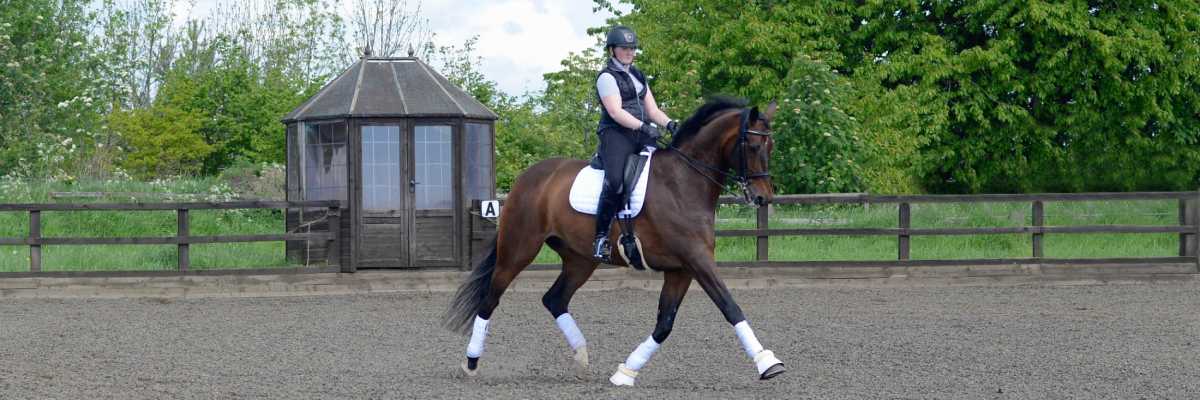
In the fourth blog of our Dressage Debunked series, International dressage rider, trainer and judge Steph Croxford discusses shoulder-in. One of the early dressage moves you would teach your horse. We look at what shoulder-in is, the purpose of it and how to ride it.
What is shoulder-in?
Shoulder-in is one of the best lateral movements for testing and improving your horse’s balance, collection, and engagement. Shoulder-in is performed in collected trot. The horse is ridden with a slight but uniform bend around the inside left of the rider, maintaining engagement and cadence and a constant angle of approximately thirty degrees. The horse’s inside foreleg passes and crosses in front of the outside foreleg, the inside hind leg steps forward under the horse’s body following the same track of the outside foreleg, with the lowering of the inside hip. The horse is bent away from the direction in which it is moving. (When viewed from the front and from behind, the horse is on three tracks).
Watch and listen to dressage rider, trainer and judge Steph Croxford explain how to ride shoulder-in:
Dressage levels explained
You will find shoulder-in at Medium level and above under British Dressage rules in the UK. In dressage tests it is ridden in trot.
The purpose of shoulder-in
Shoulder-in is one of the first movements you would train a horse to encourage collection. In the move, the horse’s shoulders come off the track and their hind end stays on the track. The purpose of shoulder-in is to make your horse supple and improve balance the horse as well as encourage the use of the hindquarters.
Learning shoulder-in early helps a rider learn to isolate control of the front and hind end of the horse without losing the horse’s shoulder position.
Dressage Debunked
Learn more from Steph Croxford with Dressage Debunked by reading our previous post, about How to Ride Travers; or our next post, about How to Ride Shoulder-in
How to ride shoulder-in
Shoulder-in is often performed in collected trot but can be done in walk and canter too. British Dressage states that the horse is ridden with a slight but uniform bend around the inside leg of the rider maintaining engagement and cadence and a constant angle of approximately 30 degrees. The horse’s inside foreleg passes and crosses in front of the outside foreleg; the inside hind leg steps forward under the horse’s body weight following the same track of the outside foreleg, with the lowering of the inside hip. The horse is bending away from the direction in which it is moving and when done correctly your horse will be on three tracks when viewed from the front or behind.
“If you have an arena mirror or someone on the ground, check whether your horse is making three tracks with their legs as they come up the arena side"
International Dressage Rider and trainer Steph Croxford, starts shoulder-in by doing a 10-metre circle in the corner. “In walk, I would do a 10-metre circle in one of the corners, and as I hit the long side of the track again after doing my circle, I would start to head down the track, bend my horse to the inside slightly getting that 30-degree bend, and wiggle my outside rein against the horse's neck to keep the bend from the 10-metre circle. The horse will want to move off onto the circle again so with your inside leg, nudge the inside shoulder down the inside track so you're heading down the long side with the inside shoulder slightly off the inside track and your horse’s neck at a 30-degree angle.
If you have an arena mirror or someone on the ground, check whether your horse is making three tracks with their legs as they come up the arena side. As a rider, position your shoulders and waist to match the front-end position of the horse and look to the end of the long side of the arena in the direction you are heading.
Where to practice shoulder-in
Shoulder-in can be ridden in an arena, a field or while hacking if it’s safe to do so. As with travers and leg yielding, it can be an effective tool to keep your horse’s attention and it’s great to use while warming up your horse to get them supple and engaged. If you attempt shoulder-in in an open space such as a field, try to have a marker on the horizon or ride near a straight line (for example a fence of a wall) to help you maintain the correct bend and direction.
Dressage rider and trainer Matt Hicks explains how to ride shoulder-in
“We use shoulder-in as a tool to suppler and straighten our horses. Eventually it becomes a good collecting exercise for more advanced horses. We’re looking for a uniformed bend through the horse's body where the horse can trot sideways with ease. This exercise is great for working on suppleness, balance and control and it’s one we would train a horse quite early on." Dressage Debunked
